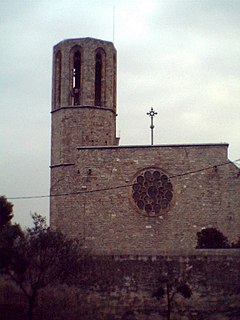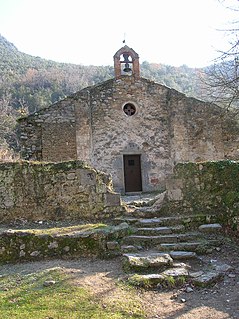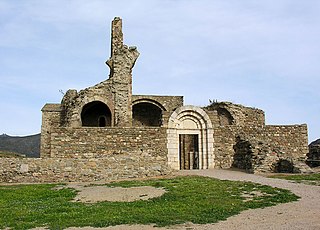
The Monastery of Santa Maria de Santes Creus, is a former Cistercian monastery in the municipality of Aiguamúrcia, Catalonia, Spain. The abbey was erected in the 12th century, in today's municipality of Aiguamurcia, in the village of Santes Creus, in the province of Tarragona (Catalonia). However, it was in the thirteenth century when Peter III of Aragon expressed his desire to be buried in the monastery and a royal crypt was built for himself and his son, King James II that many of the local nobility established the custom to choose this place for burial. This led to the monastery to increase in splendor and greatness thanks to the numerous donations received.

Sant Pere de Rodes is a former Benedictine monastery in the comarca of Alt Empordà, in the North East of Catalonia, Spain.

The Monastery of Santa Maria de Ripoll is a Benedictine monastery, built in the Romanesque style, located in the town of Ripoll in Catalonia, Spain. Although much of the present church is 19th century rebuilding, the sculptured portico is a renowned work of Romanesque art.

Serrabone Priory is a former monastery of Canons Regular in the commune of Boule-d'Amont, in Pyrénées-Orientales. The priory is located in a wild and beautiful area in the valley of the Boulès in the heart of an oak forest, at the centre of the Aspres mountain range on the eastern foothills of the Canigou, about 30 km from Perpignan.

The Monastery of Pedralbes is a Gothic monastery in Barcelona, Catalonia, Spain. It is now a museum, housing permanent exhibitions on its own art and legacy as well as third-party special exhibitions from time to time. The Chapel of St. Michael was restored and re-opened in 2018.

The Royal Abbey of Santa María de Alaón is a former Benedictine abbey, earlier a Cluniac priory, in Sopeira in the Pyrenean county of Ribagorza, Aragon, Spain, established in the late 11th or early 12th century over a 6th or 7th century foundation. The monastery is notable for its Lombard Romanesque architectural style.

Santa Maria de Gerri is a monastery in Gerri de la Sal, in the comarca of Pallars Sobirà, Catalonia, Spain, situated on the shores of the Noguera Pallaresa river.

Santa Maria d'Àneu is a Benedictine monastery in La Guingueta d'Àneu, Pallars Sobirà, Catalonia, Spain. It is known for its apse, originally painted at the church and later transferred to the Museu Nacional d'Art de Catalunya. The Romanesque monastery was documented in the year 839 in the records associated with the consecration of the Cathedral of Santa Maria d'Urgell. It is believed that it was originally a Visigoth monastery dedicated to St. Deodata. Until the late 10th century, it was dedicated to St. Peter. In the 11th century, it became a Benedictine monastery but in 1216, it was transferred to the Augustinians. By 1723, after a gradual decline, it had only one prior and a lay brother. Becoming part of the deanery of Anheu, it served as a pilgrimage center for the entire region. During the Spanish Civil War in 1936, it was burned and later replaced by a replica. The sanctuary is dedicated to the Mare d'Àneu.

Santa Cecília de Montserrat is a Benedictine monastery in Marganell, Catalonia, Spain.

Sant Esteve de Banyoles is a Benedictine monastery in Banyoles, Pla de l'Estany, Catalonia, Spain. It was declared as a Bé Cultural d'Interès Nacional landmark in 1973. The monastery was founded before 812.

Sant Llorenç de Morunys is a Benedictine monastery in Sant Llorenç de Morunys Province of Lleida, Catalonia, Spain. Built in the 11th century in Romanesque style, it was declared a Bien de Interés Cultural landmark in 1976.

Sant Pere de Casserres is a Benedictine monastery in the town of Les Masies de Roda, Osona comarca, Catalonia, Spain. The 11th-century Romanesque-style building was declared a Bien de Interés Cultural landmark in 1931.

Sant Aniol d'Aguja is a Benedictine monastery in Montagut i Oix, Province of Girona, Catalonia, Spain. It was declared a Bé Cultural d'Interès Nacional in 1983.

Santa Maria de Roses is a ruined Benedictine monastery in the municipality of Roses, Alt Empordà comarca, Catalonia, Spain. It is situated within the Ciutadella de Roses, a fortification in the Province of Girona. It is the earliest known example of Lombard architectural style in the country.

Sant Pere de Besalú is a Benedictine monastery in Besalú, Garrotxa, Catalonia, Spain. The building was renovated in 1160.

Sant Pere de Camprodon is a Benedictine monastery in Camprodon, Ripollès, Catalonia, Spain. It was declared a Bien de Interés Cultural landmark in 1931.

Santa Maria de Lavaix was a Romanesque Benedictine monastery in Pantà d'Escales in the municipality of El Pont de Suert, Alta Ribagorça, Catalonia, Spain. It was first mentioned in the 10th century. In the 13th century it fell under the Barony of Erill and in 1223 it became a Cistercians’ abbey. By the beginning of the 19th century it had declined and was finally shut down during the Ecclesiastical Confiscations of Mendizábal in 1835. Upon the construction of the Escales Dam in June 1955, the old monastery was flooded and little remains other than the walls and traces of the northeast angle of the nave.

Sant Pere de les Maleses is a Benedictine cave monastery in the municipality of La Pobla de Segur, Pallars Jussà, in the Province of Lleida, Catalonia, Spain. the monastery was first mentioned in 868 when it was dedicated to St. Andrew and was donated to St. Vincent of Oveix, the abbot of Attila. During the tenth or eleventh century it ceased to be owned by Oveix and was rededicated to St. Peter. It later fell under ownership of Santa Maria de Gerri, and lost its status as a monastery. It was secularized in 1592 and from then on became a simple church.

Sant Serni de Tavèrnoles is a Romanesque Benedictine monastery in Anserall, in the municipality of Les Valls de Valira, Alt Urgell, in the Province of Lleida, Catalonia, Spain. It became a Bien de Interés Cultural site on 3 June 1931 and was restored in 1971.

The Casbas Monastery, also known as the Monastery of Santa Maria de la Gloria, is in Casbas de Huesca, a municipality in the province of Huesca, Aragon, Spain. A Bien de Interés Cultural, it was established in 1173 by Countess Oria de Pallars with the support of her husband Arnau Mir, Count of Pallars Jussà, between 1124 and 1174, and the Bishop of Huesca, Esteve de Sant Martí. Bishop Esteve had previously been the abbot of the Cistercian Monastery of Poblet from 1160 until 1165. The first abbess was Isabel, who ruled over the 30 noblewomen who entered the community until 1182. The abbess of Casbas had civil and criminal jurisdiction over her lands beginning in 1178. The Benedictine community of women formally came under the auspices of the Cistercian order in 1196, recognized as such by Pope Celestine III.






















